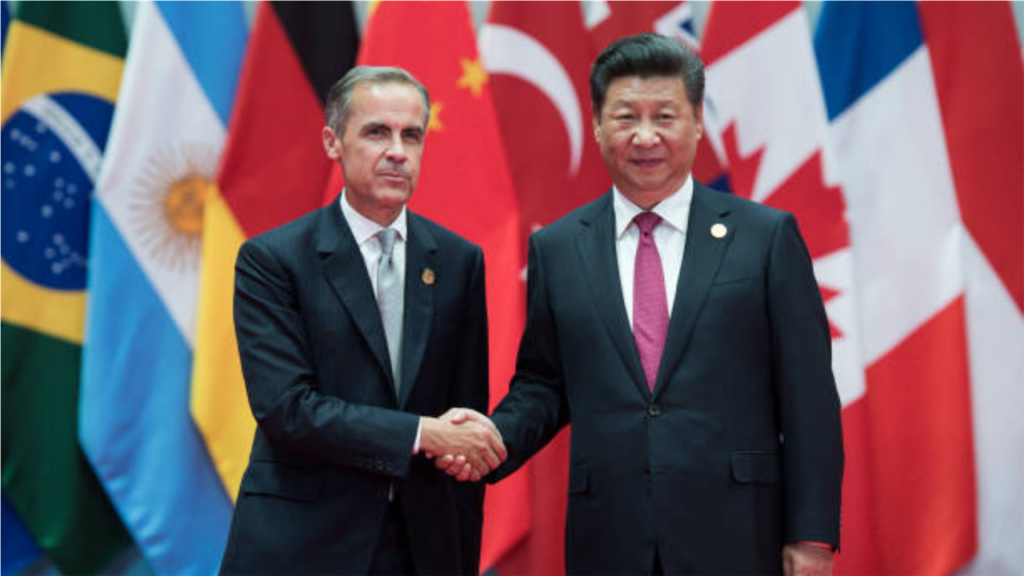UN considers allowing geoengineering for carbon credits despite UN banning geoengineering – The Expose
UN considers allowing geoengineering for carbon credits despite UN banning geoengineering
Documents from last year reveal that the UN Climate Change is considering geoengineering for carbon credits, despite the UN Convention on Biological Diversity prohibiting it.
A timeline reveals that while there are some international treaties and national regulations on geoengineering, most have no teeth.
Let’s not lose touch…Your Government and Big Tech are actively trying to censor the information reported by The Exposé to serve their own needs. Subscribe now to make sure you receive the latest uncensored news in your inbox…
Table of Contents
UN Considers Geoengineering for Carbon Credits
In 2021, The Guardian reported that an initiative to scrutinise climate geoengineering was blocked, initially by the US and Saudi Arabia, then by Japan and other countries.
These countries opposed plans to examine the risks of climate-manipulating technology such as sucking carbon out of the air, reflective mirrors in space, seeding the oceans and injecting particulates into the atmosphere.
Currently, the main prohibition on testing is the UN Convention on Biological Diversity (“CBD”), which the US is the only country not to have ratified. There are also provisions in the London Protocol which forbids ocean seeding.
The Canada-based ETC Group provided a briefing to delegates of COP16 held in Cali, Colombia, last year. The briefing was to reinforce precaution against geoengineering.
The group defines geoengineering as the intentional, large-scale technological manipulation of the Earth’s systems, often discussed as a techno-fix for combating climate change. Climate geoengineering technologies can be divided into three broad areas: so-called solar radiation management (reflecting sunlight to space), greenhouse gas removal and sequestration, and weather modification.
Solar geoengineering, also called solar radiation management (“SRM”), comprises a set of technological proposals to block sunlight from reaching the earth to reduce the earth’s temperature. The most common of the proposed techniques is stratospheric aerosol injection (“SAI”), which involves spraying sulphur dioxide (a coolant that also erodes the ozone layer) into the stratosphere.
Marine geoengineering proposals include reviving ocean fertilisation techniques (under the guise of new names); spreading synthetic reflective beads over Arctic areas; brightening marine clouds; establishing mega plantations of algae monocultures; sinking huge amounts of minerals to change ocean chemistry; and sinking large volumes of organic material and biomass into the seas to supposedly absorb carbon.
In its briefing to COP16 delegates, the ETC Group explained that all geoengineering technologies – including solar geoengineering (interventions to reflect away some sunlight back to space) and carbon removal technologies on land and/or in coastal and marine environments – imply significant impacts for ecosystems and communities.
The reasons why companies are exploring or using geoengineering is to get around the carbon rules imposed because of “climate change.”
There are more than 40 companies undertaking or planning to undertake dozens of open-sea marine geoengineering experiments and projects, some of them at large scale. At least half of the companies are already selling carbon credits in voluntary carbon markets, even in the absence of proof that carbon removal is actually taking place and/or that any removal will be permanent. Lack of efficacy, however, does not mean there won’t be impacts on marine and coastal environments and biodiversity and on the livelihoods of Indigenous Peoples and marine, Arctic and coastal communities.
It’s not only companies that are seeking to use geoengineering activities to circumvent “climate change” rules, but the UN, which is imposing these rules globally, is also considering using geoengineering to circumvent its own rules.
UNFCCC, the Supervisory Body of the Article 6.4 mechanism tasked with developing rules to govern a new carbon market regime under the Paris Agreement, has received proposals to include large-scale land and marine-based geoengineering technologies … Voluntary carbon markets are already driving geoengineering experiments, and approval of these techniques under the Paris Agreement mechanism would further legitimise them and open the floodgates to commercial exploitation.
The United Nations Framework Convention on Climate Change (“UNFCCC” or UN Climate Change) is a convention aimed at stabilising “greenhouse gas concentrations in the atmosphere at a level that will prevent dangerous human interference with the climate system.”
CBD is organised by the United Nations Environment Programme (“UNEP”). CBD is a multilateral environmental agreement focusing on the “conservation of biological diversity, the sustainable use of its components, and the fair and equitable sharing of benefits arising from the use of genetic resources.”
It is all one organisation, the United Nations. Yet, UNFCCC is considering allowing geoengineering that UNEP has banned.
Do you feel as if the public is being taken for mugs?
There are no international rules or institutions specifically on geoengineering, and where there are, they are being ignored, as a timeline of geoengineering rules and regulations reveals. Below is a timeline beginning with an article published by Scientific American in 2012, followed by what happened afterwards.
Controlling the Controllers: A Timeline of Geoengineering Rules and Regulations Worldwide
By Mollie Bloudoff-Indelicato, published by Scientific American on 25 October 2012
When it comes to attempts to actively steer the environment toward a desired outcome via geoengineering, there are some international treaties and national regulations – but most have no teeth.
The Fix Is In
When American businessman Russ George dumped iron sulphate into the Pacific Ocean last July [2011] as part of an elaborate geoengineering plan, environmental organisations around the world cried foul. But did he really do anything illegal? The body of legislation that governs geoengineering on a global scale is sparse and full of loopholes.
1966: Waging war with weather
The first global response to geoengineering was a reaction to the Pentagon’s “Project Popeye.” US Air Force planes seeded clouds to induce heavy rains over Vietnam during the war. The project was designed to destroy supplies and inhibit military movements. The international community balked at the weaponisation of geoengineering, prompting a wave of harsh criticism.
1976: UN treaty bans weaponisation of weather
After the Vietnam War, the UN General Assembly condemned Project Popeye and helped draft the international Environmental Modification Convention, or “ENMOD,” treaty. This agreement prohibits nations from deliberately altering weather for hostile purposes. Major countries like the US and Russia ratified the document, but, according to Columbia University Centre for Climate Change Law Director Michael Gerrard, it doesn’t pack much of a punch.
1976 – 2010: US has no specific legislation or agencies governing geoengineering
US legislation passed during the last few decades doesn’t mention geoengineering specifically, but laws do touch on it indirectly. Recent amendments to the 1970 Clean Air Act, for example, could prevent would-be geoengineers from tampering with the atmosphere. And although the US lacks solid rules and regulations, it is likely that its Environmental Protection Agency will be responsible for green-lighting climate projects. Any serious effort at geoengineering would require an extensive environmental impact statement.
2010: UN treaty bans geoengineering
The 193-member UN Convention on Biodiversity [“CBD”] agreed to ban climate-related geoengineering activities after a summit in Nagoya, Japan. The treaty condemns geoengineering on the grounds of unknown environmental impacts that could benefit one country but destroy another. The US refused to sign the document. [Related to this are the UK Parliament and the US House of Representatives Science & Technology Committee Final Reports and Joint Cooperating Agreements listed HERE.]
2012: The business end of geoengineering
Full-scale geoengineering experiments have the potential to trigger some serious changes in Earth’s weather patterns. Yet any attempt at passing binding laws to manage the practice is unlikely to succeed in the US, says Columbia University’s Gerrard. Climate change is a contentious topic among some American legislators. Until more policymakers reach a consensus, he says, there’s little hope for truly proactive regulations.
What’s Happened Since 2012?
There are still no international rules or institutions specifically on geoengineering. As mentioned by Scientific American, the decision of the UN Conference of the Parties to the Convention on Biological Diversity (“CBD”) in October 2010 was the first regulatory measure at this level that addressed geoengineering in general.
2011: Study as the basis for future steps
A study by the Ecologic Institute analysed the extent to which the existing international regulatory framework could be applied to geoengineering. This included the main treaty regimes such as the Biodiversity Convention, the Climate Change Convention, the Kyoto Protocol and the Convention on the Law of the Sea. Less prominent frameworks include space law and other treaties on protecting the marine environment. The study was to be the basis for future steps under the CBD.
2013: The London Convention/London Protocol
The London Convention/London Protocol aims to prevent pollution at sea. It established a precautionary governance framework for marine geoengineering in 2013, explicitly stating that ocean fertilisation should not be deployed. Fertilisation of the oceans to promote algal bloom for CO2 sequestration is the only geoengineering measure to date for which there is internationally binding legislation.
2016: UNEP moratorium on geoengineering reaffirmed
The CBD adopted a moratorium on geoengineering at COP10 in 2010 (Decision X/33), which was reaffirmed at COP11 in 2012 (Decision XI/20) and reaffirmed again at COP13 in 2016 (Decision XIII/14).
The definition of geoengineering activities to which the moratorium applies is open-ended. It includes geoengineering as defined in Annex I of a 2012 CBD document (see below), as well as definitions from ongoing work in forums other than CBD, such as the UN’s Intergovernmental Panel on Climate Change (“IPCC”) and does not exclude definitions of geoengineering activities that future deliberations may come up with.
In 2012, the CBD produced a document titled ‘Impacts of Climate-Related Geoengineering on Biological Diversity’ (see unedited version HERE and final published version HERE). Annex I, titled ‘Summary Of Selected Definitions Of Climate-Related Geoengineering’, lists 10 sources. The brief descriptions of all except for two (numbers 2 and 10 in the image below) include the words “large scale” or “massive.”
The last on the list, number 10, is a report from the 2010 Asilomar Conference. In 2010, at the Asilomar International Conference on Climate Intervention Technologies, 200 scientists gathered to determine how geoengineering research should proceed. What emerged from the conference were some unexpected lessons about the possibilities and pitfalls of manipulating the earth’s climate to offset global warming.
Related: The Barcode of Life – Do We Really Understand What It Is and What It Aims To Do?
The short description for the Asilomar Conference’s definition of geoengineering is “deliberate steps to alter the climate, with the intent of limiting or counterbalancing the unintended changes to the climate resulting from human activities.” If this definition can be taken at face value, Bill Gates and Harvard University are deliberately ignoring the moratorium on geoengineering.
In 2022, Bill Gates openly admitted to funding Harvard University’s SCoPEx chemtrail experiments to “create a global cooling effect” to counteract anthropogenic global warming. In its briefing to COP16 delegates, ETC Group noted SCoPEx as one of the “rogue solar geoengineering experiments” that are “likely in contravention of CBD decisions on geoengineering.”
In 2021, Harvard University announced a solar geoengineering field experiment above Kiruna in Sweden’s Lapland, but the action was suspended following Indigenous and civil society protests led by the Sámi Council. The project, called SCoPEx, proposed a solar geoengineering experiment in Arizona as well, but that was rejected by Indigenous Peoples there. SCoPEx suspended its work in 2023 and officially closed in 2024, but one of its two initiators, David Keith, has left Harvard and moved on to the University of Chicago to lead a broader “Climate Systems Engineering Initiative.”
Reinforcing Precaution Against Geoengineering To Protect Biodiversity And Communities, Briefing for Delegates at COP16, Cali, Colombia, 21 October – 01 November 2024, ETC Group, pgs. 5 & 6
2024: COP16 reaffirms moratorium
By consensus, COP16 – held in Cali, Colombia, from 21 October to 1 November 2024 – reaffirmed its moratorium on climate geoengineering and the previous one on ocean fertilisation (Decision IX/16 C). The COP16 decision even went further than the original decision taken in 2010 by urging CBD Parties and encouraging other governments to ensure their implementation:
If there has been a moratorium on geoengineering since 2010, why is it being allowed to continue? If you didn’t realise it before, you should be seeing it now. The UN is, at best, a joke. Countries should leave the UN and stop giving it money.
” data-image-caption=”
#image_title
” data-medium-file=”https://i0.wp.com/expose-news.com/wp-content/uploads/2025/04/FtApr4b.png?fit=300%2C169&ssl=1″ data-large-file=”https://i0.wp.com/expose-news.com/wp-content/uploads/2025/04/FtApr4b.png?fit=639%2C359&ssl=1″>
While previously it was a hobby culminating in writing articles for Wikipedia (until things made a drastic and undeniable turn in 2020) and a few books for private consumption, since March 2020 I have become a full-time researcher and writer in reaction to the global takeover that came into full view with the introduction of covid-19. For most of my life, I have tried to raise awareness that a small group of people planned to take over the world for their own benefit. There was no way I was going to sit back quietly and simply let them do it once they made their final move.














